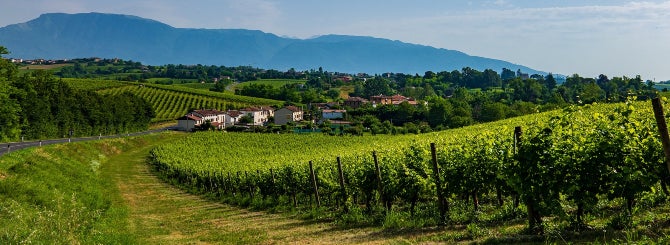
As much as people appreciate novelty, historically, they don't embrace changes to a region, person or brand's core identity.
Just look at Harley Davidson's attempt to release a perfume line, or Snoop Dogg's insistence on being referred to as Snoop Lion, or the widespread adoption – and then reversal – of international varieties in wine regions with centuries of history creating wine from autochthonous varietals.
| Related stories: |
| The World's Most Expensive Proseccos |
| The Unlikely Rise of Premium Pinot Grigio |
| Prosecco Aims for Champagne Status |
Which is why it has been fascinating at times, and alarming at others to witness the fast-paced evolution in Prosecco. Some of the changes have arguably underlined Prosecco’s historical identity. But others, which are that are arguably less aligned with traditional practices, appear to be potentially destabilizing for producers, and confusing for consumers.
Major changes in a nutshell
Prosecco has been produced in northeastern Italy for centuries, primarily from a thin-skinned green grape. The grape was long known interchangeably as Prosecco and Glera, until 2009, when the rise of plantings in regions outside of Italy prompted regional authorities to lock in legal protection of the name, a la Champagne.
The region in which the sparkling wine is produced became Prosecco, and the grape became Glera. From then on, to label a wine Prosecco, it had to be grown and produced in the region itself.
This change also constituted an upgrade for the region from Indicazione Geografica Tipica (IGT) status to Denominazione di Origine Controllata (DOC). Around the same time, what many saw as the crème de la crème of Prosecco – the Prosecco di Conegliano e Valdobbiadine DOC zone – got an additional elevation, to Denominazione di Origine Controllata e Garantita (DOCG).
The Prosecco DOC encompassed nine provinces in Veneto and Friuli-Venezia Giulia, and wine produced from anywhere and everywhere within the bounds under the basic grape variety and quality control rules can be labeled as such. A step up is wine labeled Treviso and Trieste, which indicates that the wines are grown and produced there, even though they aren't themselves DOCs, they can be an additional mention on the DOC label.
Further up the ladder are DOCG regions like Asolo Prosecco DOCG and Conegliano Valdobbiadene Prosecco Superiore DOCG, which in turn includes sub-DOCGs, including Valdobbiadene Superiore di Cartizze DOCG. They must be grown and produced within the strict boundaries of the region, with stricter quality and quantity rules in place than DOC zones.
Those changes, to most insiders and outsiders, serve as a kind of cheat sheet that will clearly broadcast what can be expected from the contents of the bottle: from cheap and cheerful to elegant and refined.
But then 2020 happened. In May, just as the pandemic was putting the world in a straitjacket, the Prosecco DOC approved the creation of Prosecco Rosé. Typically, Prosecco has been made from 85 percent Glera grapes, with the option of adding other permitted varieties like Pinot Bianco, Pinot Grigio, Bianchetta Trevigiana, Chardonnay and Pinot Nero (if fermented off the skins); this rule opened the door to already permitted grapes and Pinot Nero fermented on-skin.
There have also been other notable trendlets, like an increased focus on producing aged Proseccos, single-vineyard Proseccos – and, most notably, Proseccos not produced in the Charmat method.
If sales are an indication, people are embracing many of the changes. More than 638 million bottles of Prosecco DOC were sold last year, with values up 11.5 percent, and volume of 1.8 percent. More than 81 percent of the wine was exported.
But there are indications, especially within Prosecco itself, that some of these changes are not only unwelcome, but represent a perceived threat to the identity and future of the region. Read on for both sides of the story.
Prosecco Rosé
Stefano Zanette, president of the Consorzio di Tutela Prosecco DOC strongly believes that creating a rosé category not only "does not pose a threat to dilute the denomination, but reinforces it".
Zanette notes the strong export market for Prosecco, and says that creating a rosé is in many ways, a recognition of the incredible thirst worldwide for drinking pink. He also argues that there is a long history of making rosé in the region.
"It already existed here, and there is growing market demand," Zanette says. "When we researched it, we found that 57 percent of the 348 wineries in the DOC Prosecco area were already producing rosé sparkling wines with grape varieties like Glera and Pinot Noir using the Martinotti/Charmat method."
But more to the point, he says that creating a Prosecco Rosé under the DOC's umbrella, ensures that quality.
"By determining the practices to follow in the vineyard and cellar, we believe it will increase the quality and give consumers a better product with a defined origin," he explains.

Enore Ceola, CEO of Freixenet Mionetto USA, has been revving its rosé engines for years.
"Before the official category expansion, our head winemaker Alessio del Savio was already creating a sparkling rosé," he says. "We continue to grow that category, and it has become a key driver in our portfolio’s success."
Others are less enthusiastic.
The Consortium of Conegliano Valdobbiadene Prosecco Superiore released a bristling statement about rosé when it was approved in 2020, saying that as defenders of the "strength, identity, culture and quality of Prosecco", they could not "take into consideration the hypothesis of introducing in the rules of production the 'rosé' version" of Prosecco.
The statement continued: "In the historic area for Prosecco production, Conegliano Valdobbiadene, where the Glera grape is grown and produced, the cultivation of Pinot Noir is nearly nonexistent. Also from a technical point of view, the rosé hypothesis would be not compatible, because the traditional blend with Chardonnay and/or Pinots – for a quantity of maximum 15 percent – is meant to complete the wine produced with Glera grape (for a quantity of at least 85 percent) and not change completely its profile."
Luigi Bortolomiol, co-owner of the family-run Spumanti Gemin in Conegliano Valdobbiadene, sees Prosecco Rosé as nothing more than "a passing trend".
"We as a winery have never thought of producing it as it would conflict with our territorial production philosophy," Bortolomiol says. "Pinot Noir has never been present as a vine in our area."
Metodo Classico vs. Martinotti-Charmat
When Prosecco was first made, it was produced using the ancestral method.
But in 1895, Italian winemaker Federico Martinotti patented a method of winemaking that ensured sparkling wine could be created faster and more efficiently than it could be with the traditional method. In 1907, the Frenchman Eugene Charmat refined the process and created his own patent. Antonio Carpene Sr. refined both methods further, and created the standards whereby Prosecco is made today.
Today, the Martinotti-Charmat method, also often known as the Italian or tank method – and which entails fermenting wine in a pressurized tank, which helps create bubbles and lock in Glera’s freshness – is practically synonymous with Prosecco.
For many, a Prosecco made without the Charmat method is not a Prosecco at all, and perhaps more essentially, is not suitable for the Glera grape, which is high in acid, and features distinct, fresh aromas of orchard fruit and white flowers that can be diminished if not locked in through Charmat.
"The Charmat method is the most suitable for enhancing the perfumes and aromas of sparkling wines made using aromatic and semi-aromatic grapes, like Glera," says Primo Franco, owner of the historic Nino Franco in Valdobbiadene.
Diego Tomasi, director of the Consortium Valdobbiadene Prosecco Superiore DOCG, agrees.
"Certainly the Charmat – or rather Martionotti – method is the best method," he says. "It preserves and enhances the aromatic properties of the Glera grape variety. It offers very sensitive and diversified aromas depending on the site of the cultivation, so the Martinotti method preserves the full aromaticity and freshness of the grapes."
But others argue that there is a space for other methods of making Prosecco.
"Prosecco is a wine that is meant to be consumed fresh in order to appreciate its wonderful fruity and floral notes," says Matteo Bolla, business development manager for Valdo USA. "We have always been careful to maintain the tradition, but we are also leading the way for innovation in the Prosecco Superiore category by creating unique cuvées."
One, the Cuvée del Fondatore Valdobbiadene DOC, with 90 percent Glera, features 10 percent Chardonnay, aged in French oak barrels for six months, to stabilize the wine "and add notes of vanilla", he explains. "The wine is then blended with Glera and undergoes a 12-month Charmat-Martinotti method ending with a brut dosage and a truly unique profile for Prosecco Superiore DOCG."
While Bolla maintains that the Charmat-Martinotti method is "the way to craft a fresh, easy to drink Prosecco", and that 99.9 percent of Prosecco should in fact be made this way, "the 0.1 percent that is made via the Metodo Classico, which requires expertise in the vineyards and in the cellar, as we do with our Numbero 10 Valdobbiadene DOCG, the perfect balance of fruity and floral notes, with yeasty character and toasted bread aromas" can be achieved.
Others, like Giancarlo Motetti Polegato, owner and president of Villa Sandi, prefer the Charmat production method, but are pushing the envelope with "longer maturation on the lees".
"Our La Rivetta 120 gets 120 days on the lees," Polegato says. "A longer period than what the production laws state, but not as long as the Classic Method. The result is still a fresh wine, reflecting what consumers expect from a Prosecco, which is liveliness, lightness, floral and fruity notes. But the longer period also grants a long-lasting lingering note in the mouth."
Singular expressions
Prosecco producers – especially those in DOCGs – are increasingly exploring expressions that showcase favored vineyards and terroirs.
"Villa Sandi owns n estate covering one and a half hectares in the middle of the Cartizze hill, the top cru of the Conegliano-Valdobbiadene area," Polegato says. "This micro-area is blessed with a gentle microclimate and ancient, fertile soil."
The limited production Cartizze La Rivetta has been selected as Grandi Cru d'Italia, an honor only given to the most prestigious vintners in Italy.
Tomasi says that the Conegliano Valdobbiadene Prosecco Superiore DOCG sees these singular expressions as the future.
"We are very much pushing and enhancing the Rive, our 43 territorial selections based on specific soils and climates that make it possible to obtain a wine with unique and highly distinctive characteristics," Tomasi notes.
This year alone, the DOCG has seen a 90 percent increase in requests for Rive from buyers, and he predicts that in the coming years, it will grow to the roughly 10 percent of production it stands at today to up to 40 percent.
Is Prosecco, like Taylor Swift – who has comfortably navigated country, pop, folk and alt-rock without imperiling her core identity, or the perception thereof – not only impervious to market trends, but, in many ways in control of them?
Ceola would argue that his brand, and Prosecco as a whole, is.
"Innovation is at the core of our DNA," he says, noting Mionetto's pioneering focus on organic grapes, rosé and single-vineyard vintage Proseccos.
Trend-watchers take note: next year, Mionetto will be offering the first non-alcohol sparkling wine with the same residual sugar of traditional Prosecco Brut, and only 14-calories per five-ounce serving.
It's too early to say what rosé, method traditional and single-vineyard – never mind low-calorie and alcohol-free – Prosecco will mean for the region and individual producers. But it will be fun to watch, preferably with a glass of sparkling Glera in hand.






















